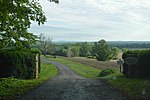Second Battle of Rappahannock Station
1863 in VirginiaBattles of the American Civil War in VirginiaBattles of the Eastern Theater of the American Civil WarBristoe campaignConflicts in 1863 ... and 5 more
Culpeper County in the American Civil WarFauquier County in the American Civil WarNovember 1863 eventsRappahannock RiverUnion victories of the American Civil War
The Second Battle of Rappahannock Station took place on November 7, 1863, near the village of Rappahannock Station (now Remington, Virginia), on the Orange and Alexandria Railroad. It was between Confederate forces under Maj. Gen. Jubal Early and Union forces under Maj. Gen. John Sedgwick as part of the Bristoe Campaign of the American Civil War. The battle resulted in a victory for the Union.
Excerpt from the Wikipedia article Second Battle of Rappahannock Station (License: CC BY-SA 3.0, Authors).Second Battle of Rappahannock Station
Godwins Landing,
Geographical coordinates (GPS) Address Nearby Places Show on map
Geographical coordinates (GPS)
| Latitude | Longitude |
|---|---|
| N 38.533 ° | E -77.8136 ° |
Address
Godwins Landing 5094
22734
Virginia, United States
Open on Google Maps







